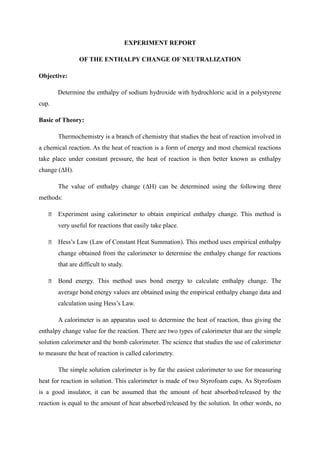
Entalphy's Experiment report
- 1. EXPERIMENT REPORT OF THE ENTHALPY CHANGE OF NEUTRALIZATION Objective: Determine the enthalpy of sodium hydroxide with hydrochloric acid in a polystyrene cup. Basic of Theory: Thermochemistry is a branch of chemistry that studies the heat of reaction involved in a chemical reaction. As the heat of reaction is a form of energy and most chemical reactions take place under constant pressure, the heat of reaction is then better known as enthalpy change (ΔH). The value of enthalpy change (ΔH) can be determined using the following three methods: Experiment using calorimeter to obtain empirical enthalpy change. This method is very useful for reactions that easily take place. Hess’s Law (Law of Constant Heat Summation). This method uses empirical enthalpy change obtained from the calorimeter to determine the enthalpy change for reactions that are difficult to study. Bond energy. This method uses bond energy to calculate enthalpy change. The average bond energy values are obtained using the empirical enthalpy change data and calculation using Hess’s Law. A calorimeter is an apparatus used to determine the heat of reaction, thus giving the enthalpy change value for the reaction. There are two types of calorimeter that are the simple solution calorimeter and the bomb calorimeter. The science that studies the use of calorimeter to measure the heat of reaction is called calorimetry. The simple solution calorimeter is by far the easiest calorimeter to use for measuring heat for reaction in solution. This calorimeter is made of two Styrofoam cups. As Styrofoam is a good insulator, it can be assumed that the amount of heat absorbed/released by the reaction is equal to the amount of heat absorbed/released by the solution. In other words, no
- 2. heat is absorbed/released by the system (insulated/adiabatic system). Based on this, we can write: qreaction + qsolution = 0 qreaction = -qsolution qreaction = -m x c x ΔT Where: qreaction : heat absorbed or released (J or kJ) m : mass (g or kg) c : specific heat (J g-1o C-1 or J kg-1 K-1 ) ΔT : temperature change (o C or K) At constant pressure, the enthalpy change is the same as the heat of reaction. As the measurement for the heat of reaction in a simple solution calorimeter is carried out at constant pressure, and then we obtain: ΔH = qreaction = -m x c x ΔT The bomb calorimeter is a device that is used to measure the heat of reaction, with a high level of accuracy. This type of calorimeter is commonly used for reactions that involve gases, especially for combustion that takes place at high temperature and forms gaseous substances. Basically, a bomb calorimeter consists of a sealed container, like a bomb, where the chemical reaction takes place. The container is surrounded by water and is equipped with a stirrer and a thermometer. To determine the heat of reaction, the sample is placed inside the bomb including the gaseous substance that will enter via a separate valve. Once the reaction is initiated, a transfer of heat will take place between the reaction and the calorimeter. This will result in a change in temperature of the calorimeter (water and the other parts of calorimeter) as indicated by the thermometer. Let us assume that the transfer of heat only takes place between the chemical reaction and the bomb calorimeter so that no heat from the system can get out into the surroundings (insulated/adiabatic system). As the bomb calorimeter is composed of various components, we will use a thermal property called the heat capacity (C) to determine the heat absorbed by the calorimeter. So, we can write:
- 3. qreaction + qcalorimeter = 0 qreaction = -qcalorimeter qreaction = -Ccalorimeter ΔT Where: Ccalorimeter : heat capacity of calorimeter (J g-1o C-1 or J kg-1 K-1 ) ΔT : temperature change (o C or K) At constant volume, the enthalpy change is approximately equal to the heat of reaction. As the measurement for the heat of reaction in a bomb calorimeter is carried out at constant volume, and then we obtain: ΔH = qreaction = -Ccalorimeter x ΔT Equipments and Materials: Equipments: One unit of calorimeter One unit of thermometer One unit of Erlenmeyer flask One unit of beaker glass One unit of measuring cylinder One unit of pipette One unit of filter funnel Materials: Water HCL
- 4. NaOH Procedures: 1. Place 150 cm3 of 1.0 mol dm-3 hydrochloric acid in the cup and record its temperature. 2. Add 50 cm3 of 1.0 mol dm-3 sodium hydroxide (at the same temperature) to the acid in the cup. 3. Stir the reaction mixture with the temperature and record the highest temperature. Observation data: N o Experiment Initial Temperature T1 (O C) Finished Temperature T2 (O C) 1 Solution Of Naoh 26o C 26.5o C 2 Solution Of HCL 26o C 26o C 3 Average Temperature 26o C 26.25o C 4 Final Temperature 27o C 27o C 5 Increased Temperature 1o C 0.75o C Discussion: Question and answer: 1. Calculate mole of NaOH in 50 cm3 NaOH 0.1M of solution and mole of HCL in 50 cm3 HCL 0.1M of solution. Answer: mole NaOH= concentration x volume 1x10-1 x 5 x10-2 = 0.5 mole
- 5. Mole HCl= concentration x volume 1 x 10-1 x 5 x 10-2 = 0.5 mole 2. Calculate the energy transferred from the experiment! Answer: Q = m x c x T Q = 50 x 4.18 x 0.75 Q = 156.75 J Conclusion:
- 6. Mole HCl= concentration x volume 1 x 10-1 x 5 x 10-2 = 0.5 mole 2. Calculate the energy transferred from the experiment! Answer: Q = m x c x T Q = 50 x 4.18 x 0.75 Q = 156.75 J Conclusion:
